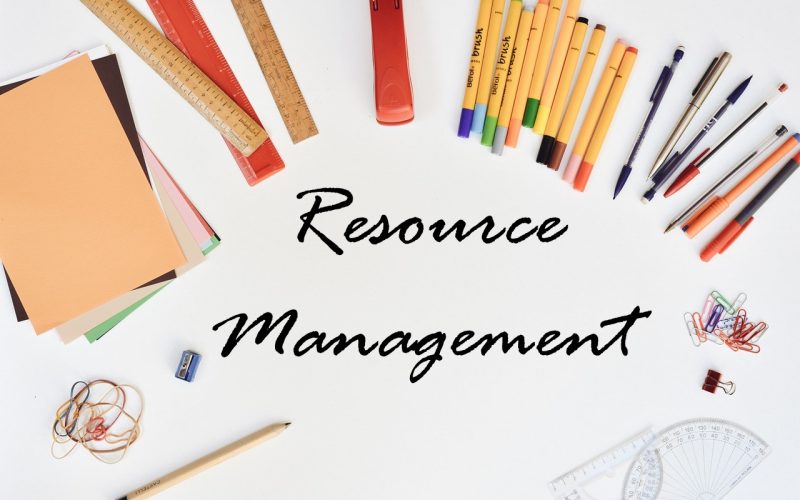Having the ability to effectively manage every resource in your business is a big step toward your company’s growth. This article explains what resource management is, why resource management is important, and the types, skills, plans, and examples. This is great insight! Do enjoy and apply them.
What is Resource Management?
Resource management is the process of employing various sorts of corporate resources efficiently and successfully. Moreover, these resources can include human resources, assets, facilities, and equipment, among other things.
Additionally, it is the planning, scheduling, and prospective allocation of resources to the appropriate project at the appropriate time and cost. A firm’s resource management strategy enables firms to make the best use of their trained personnel while increasing profitability.
Why Is Resource Management Important?
Managing resources is essential to enhancing a company’s profitability and sustainability. Let us look at how resource management can contribute to both the upper and, lower lines of any business.
1. Importance of resource management: Significantly reduce project resource expenses
Resource managers can use cost-effective world resources from low-cost locales with enterprise-wide visibility. Further, getting the proper mix of local and global resources aids in project expense reduction. By delivering the resources to the right project, they are capable of completing the delivery on time and within budget. In addition, resource managers can keep costs under control by spreading critical resources evenly across all projects rather than focusing on a single high-priority project.
2. Importance of resource management: Improving resource utilization that is effective and chargeable
Managers can use resource management tools to forecast labor usage in advance. As a result, resources can be reallocated from non-billable to billable and strategic tasks. Whenever resources are taken off from projects, there may be no suitable work to engage them in. As a result, these resources are gradually pushed to the sidelines. Then, resource managers can use these resources for non-billable tasks at first before rapidly assigning them to billable/strategic initiatives.
3. Importance of resource management: Proactively Bridge the capacity vs. demand gap proactively
Demand forecasting, a component of project resource management, enables managers to anticipate resource demand in advance. It allows them to measure and analyze the skills gap within their current capacity. Following the identification of shortages and excesses, resource managers can develop an action plan to proactively bridge the capacity vs demand gap.
4. Important resource management: Make effective use of restricted resources in a matrix organization.
The resource management process improves communication transparency and therefore allows for the successful sharing of highly trained resources in a matrix organization. Instead of focusing on a single high-priority project, scarce resources can be spread over multiple projects. The shared services approach will also build teams that span several geographies to provide 24 * 7 assistance.
5. Important resource management: Keep track of and enhance the organization’s health index.
Employees look up to their managers for professional development opportunities. Failure to motivate and give opportunities for career growth will primarily result in lower engagement, productivity, and unintended turnover. Finally, checking their abilities and productivity on a regular basis might help them improve and bring more value to the firm.
Resource Management Skills
Skills for managing any resources are a must in every organization. Here is a list of essential skills
#1. Resource Management Skills: Communication
Resource managers are responsible for satisfying project managers’ resource requirements by distributing the job to the appropriate resource. Because they serve as mediators in this process, they must be excellent communicators. Further, it will allow them to better clarify roles and duties to resources while also making reasoning with project managers easier.
#2. Resource Management Skills: Dispute Resolution
Frequently, numerous project managers will request similar-skilled resources. In this instance, if the project prioritizing criteria are not in place, disputes may arise. In addition, a lack of clarity in establishing goals and objectives can leave resources in the dark, leading to inconsistencies. Therefore, a resource manager’s role is to intervene, set clear expectations, and ensure that are all on the same page in order to keep the task moving forward. This is why conflict resolution skills are required.
#3. Resource Management Skills: Domain knowledge
Because it is the responsibility of resource managers to assign the correct resource to the right job. It is critical that they have a thorough understanding of the expertise. For instance, working for an engineering firm with a resource manager who has no engineering skills will present resource planning issues in the long term. To gain additional clarity, they must have domain expertise.
#4. Resource Management Skills: Proactive planning
Every project manager strives to execute the project on time and under budget, thus preparing ahead of time is essential. And the ability to manage time well because time is an asset managing it is very vital. Because success is heavily reliant on the workforce, resource managers must be particularly proactive in order to meet demand. They must be quick-witted in order to make sound decisions regarding applying the appropriate resourcing remedies.
#5. Resource Management Skills: Negotiating skills
Resource planning is a demanding profession that presents resource management with a slew of challenges. A project manager, for example, has asked an individual with superior technical expertise. If talent is missing and it is too costly to recruit another resource, managers must persuade the project owners. Managers must be able to negotiate effectively and get the work done in such situations.
#6. Resource Management Skills: Risk management
What if a resource goes on unscheduled leave for an extended period of time? What if there is unintentional attrition? A running project can be brought to a halt. What steps might a resource manager take in this situation? These scenarios will appear manageable if they have a backup plan in place. So, in the project landscape, risks are unavoidable. As a result, resource managers must polish their risk management skills through forward planning in order to keep the project on track.
Four Types of Resource Management
#1. Types of Resource Management: Physical
These are tangible assets used by the firm to produce value offerings and value propositions for its consumers. Moreover, Physical resources may include equipment, facilities, inventories, a manufacturing plant, and a distribution network, all of which are critical to the business’s success.
Physical resources are vital for the organization’s operation because it is difficult for the business to run without items such as equipment, inventories, and a manufacturing plant. Since these are essential for businesses with a tangible product offering. A manufacturing plant, delivery system, and so on are not required for businesses with intangible service offerings.
#2. Types of Resource Management: Human
Human resources are also vital in dealing with customers. Again, as troubleshooters in order to grasp the nature of the client’s problem and deliver personalized solutions. For instance, FedEx truck drivers are human resources who collaborate with physical resources such as vehicles to deliver things to FedEx clients and create an experience that is unique to FedEx.
#3. Types of Resource Management: Monetary Resources
These frequently include cash, credit, and lines of credit, as well as the opportunity to offer stock options to the organization’s personnel. Most organizations have financial resources on a regular basis. but only a few have highly strong financial resources, such as banks, which are totally reliant on financial resources and rely on them as a primary resource.
Likewise, insurance businesses operate purely on a financial basis and view finance as the organization’s ultimate resource. In the scenario of a mobile manufacturer, for instance, the physical resource would be assembly materials like glass, hardware pieces, plastic, and other materials built by robots.
#4. Types of Resource Management: Intellectual
This is the type of business resource that is nonphysical and intangible in nature. such as product patents, brand names, copyright over important materials, and even partnerships. Customer data and expertise, as well as the organization’s personnel, can all be considered intellectual resources. Once established, they might provide unique benefits to the organization.
Examples of Resource Management
Here are a few examples of resources management
- Air
- Soil conversation
- Forestry
- Animal
- Water Management.
Resource Management Plans
A resource plan outlines how human and physical resources will be estimated, obtained, developed, managed, and regulated. Meanwhile, people are developed and managed, whereas materials are controlled once they have been calculated and purchased.
#1. Resource Management Plans: Recognition and Reward Systems
Setting up a system to reward resources can be a time-consuming process. A project manager must be able to inspire his or her team, which is especially important while working on a project in a matrix organization. Irrespective of the reporting relationship, rewards and recognition are some of the most effective methods of motivating and gaining cooperation from your team. Several acts, for example, the following could be included in the reward system.
- Say please and thank you more frequently.
- Recognition for Team Member of the Month is one example of an award.
- Giving out prizes for excellence is paramount.
- Recommend team members for promotions or new job assignments.
- Send congratulations to team members’ managers for their outstanding work.
- Plan milestone celebrations or other events.
- Obtain training for members of your team.
- As an incentive, adjust the project such that workers are assigned to activities they have been waiting to work on or are removed from unwanted ones.
Developing a reward and recognition system necessitates significant planning before beginning project work.
#2. Resource Management Plans: Team Acquirement
The following are some of the factors that influence Team acquirement;
Project management strategy; The project management strategy must include a human plan. Environmental Issues in Business Process Assets in Organizations Putting together a project team entails the following steps:
- First of all, The project manager should bargain for the best possible resource management plans.
- Secondly, New employee recruitment
- Another one is Collaboration with virtual groups
- Lastly, Managing the hazards associated with limited resources
#3. Resource Management Plans: Pre Assignment
The project is given certain resources ahead of time. These resources must be managed by the project manager.
Are there techniques that can help businesses manage their resources?
Yes, there are. You can forecast, allocate resources, or level your resources to get the most from them. Let’s elaborate on this below
#1. Resource forecasting
In order to maximize the effectiveness of people, materials, and budgets, you must have a resource management plan. Before a project starts, resource forecasting enables you to foresee your future resource needs. You might think about resource management software that predicts the project’s scope, potential restrictions, unforeseen costs, and potential dangers throughout the planning stages of a project.
#2. Resource Allocation
You can maximize the use of your resources by allocating them. This involves effectively distributing the resources at your disposal on the various project at hand. In doing this, ensure you have team members who understand your goal and objective. Allocating resources help you not to overspend on any project.
#3. Resource leveling
It isn’t just enough to allocate resources. You must ensure that someone keeps a close watch on it too. This will reveal resources that are not being maximized or not efficiently used within your business. And then, deploying them to effective use.
What Is the Aim of Resource Management?
Let’s start by giving resource management a brief definition. It involves the process of efficiently planning, scheduling, and allocating organizational and project resources. from the very beginning of your projects all the way to completion. The accomplishment of project, task, or organizational goals is its ultimate goal.
What Are the Four Essentials of Resource Management?
Planning, scheduling, forecasting, and optimizing the full resource lifecycle for successful project delivery is the process of managing resources.
What Are Importance of Resources?
Any country’s development depends on its resources. For instance, fossil fuels are needed to produce energy, and mineral resources are needed to advance industrial development. 6. Ecological and socio-economic issues are the result of excessive and irrational use of natural resources.
What Is Resource Management Research?
Resource management is the process of increasing productivity and directing when and how resources, such as staff, tools, and equipment, are used. All of the things needed to accomplish objectives are resources. They might also include money, space, and technology.
What Function Do Resources Serve in a Project?
A resource is a valuable asset that is primarily used to support the completion of a specific activity or project. A resource may be a person, a group, a piece of equipment, money, or time. The majority of projects need a variety of resources to be finished.
Why Is Resource Management Difficult?
Problems with resource management are inherent to working in teams. Planning the work and resources needed to manage several projects at once is frequently necessary. The important components of project resource management that can make or fail your projects are organizing, monitoring, and improving processes.
What Is Poor Resource Management?
The stability and success of organizational processes are threatened by a system of inefficiencies that are the result of poor resource management. Every area of an organization may be affected, from interdepartmental cooperation to strategic planning and execution.
Conclusion
Resource Management is a system that helps an organization to be in place.
Resource Management FAQs
What are the 5 resources of management?
Since man became victorious in the industrial revolution, every business has been using these five M’s: man, materials, machines, minutes, and money; to operate with, or without, success. To create any venture without any one of these M’s is simply embarking on a journey to Erehwon.
What are the four steps of resource management?
- Firstly, determine the required resources.
- Secondly, acquire resources.
- Thirdly, manage resources.
- Finally, control resource usage.
What are some examples of resource management?
In conservation, resources management is a set of practices pertaining to maintaining natural systems’ integrity. Examples of this form of management are air, soil conservation, forestry, wildlife management, and water resource management.
- The Importance of Resources for the Success of Any Business
- Human Resources Management (HRM): Definition, Outsourcing, and Functions
- FINANCIAL RESOURCES: 7 Best Sources too look out for in 2023 (+ Detailed Guide)
- Human Resource Management: Definition and Guide For Small Businesses
- Management Reports: Guidelines for Management Reporting






